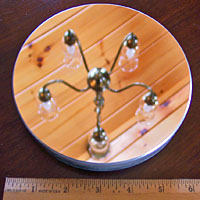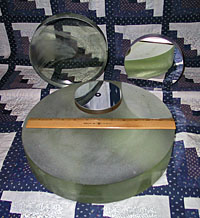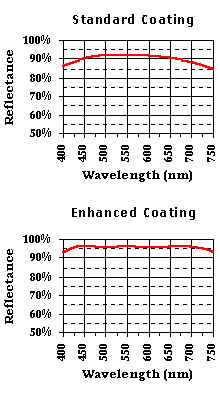

The Primary Mirror

Unarguably, the Primary Mirror is the single most critical component of your telescope. It gathers and focuses the light you will be viewing, and it's size, weight and focal length set the major dimensions and performance characteristics of your telescope. It is also likely to be the most expensive single component of your telescope, or if you are making your own mirror, the one that takes the most time to produce.
On this page will will discuss the characteristics of the primary mirror, so you can make an informed decision on what to buy or build.
If you plan to make your own mirror, please do that before you work on the telescope. See our Mirror Making Guide for this. If you plan to purchase a new primary mirror, you can check our Suppliers List to see which vendors might have what you are looking for. You might also want to check auction sights like eBay or astronomy specific want ads like Astromart or Cloudy Nights when shopping for your mirror.
Mirror Diameter
The diameter of you primary mirror determines how much light your telescope can gather. Since much of amateur astronomy is concerned with making dim objects bright enough to see, this is very important. While you can make a mirror in any size you want, mirror blanks and finished mirrors come in some well defined standard sizes: 4¼, 6, 8, 10, and 12½ inch are the standard sizes for the type of telescope we are building. Each step up in the standard sizes provides 56% to 77% more surface area, and hence that much more light to be focused into your eye. But size comes at the cost of weight, telescope size, longer thermal cool-down times and cost. For a first telescope, we recommend a 6 or 8 inch mirror diameter.
Focal Length & Focal Ratio
Mirror Diameter, Focal Length and Focal Ratio are related by the formula:
Focal Length / Mirror Diameter = Focal Ratio
Knowing the mirror diameter makes Focal Length and Focal Ratio interchangeable with the above formula. Below we will talk in terms of Focal Length, as it is more physically significant to most people, but when shopping for a mirror you will need to know the Focal Ratio also, as that is often specified instead of Focal Length.
A long Focal Length results in a long telescope tube, making it less transportable, harder to store and in some cases requiring a step stool or ladder to reach the eyepiece when aimed high in the sky. Long focal length mirrors also have narrower maximum fields of view, with corresponding higher maximum magnifications. Conversely, shorter focal length mirrors have wider fields of view and smaller maximum magnifications. Many beginners think high magnification is important, and generally it is not. Many people prefer to observe at lower magnifications with a corresponding wider field of view. That is certainly easier for a beginner also.
We recommend a 48 inch focal length for a first telescope. (Note that we are building a 6 inch f/7.5 telescope, which has a 45 inch focal length - certainly close enough to fall within our recommendation.)
Parabola or Sphere

You should be buying a Parabolic primary mirror - that is the shape of the mirror surface. A parabola is the shape that will focus rays from a distant source to a sharp focus (Your satellite TV dish is also a parabola, it works for radio waves too!). Some inexpensive primary mirrors are sold with a spherical shape on the mirror surface, which will not focus light rays sharply, and they have Spherical Aberration as a consequence.
There is one exception to the rule - if you are buying an very long focus mirror in the f/12 or higher range, it may be that the spherical aberration is so slight as not to be detectable by the human eye. The smaller the mirror, the more forgiving it is. If you are following our recommendations, however, you need a parabolic primary for scopes in the 48" focal length range.
Mirror Thickness
A "full thickness" mirror is one in which the the thickness is at least 1/6 of its diameter; a "thin mirror" has less thickness. While thickness adds to weight, cost and thermal cool-down time, it also adds to stiffness, and the mirror can hold it's shape and not distort the light it is reflecting in a simple mirror cell. Thin mirrors need special flotation cells to prevent this distortion. We specify a full thickness mirror because we are building a simple mirror cell.
Glass Type
There are many glass types, but chances are you will be presented with only two choices in buying your primary mirror: Plate or Float Glass; and Borosilicate Glass, usually specified by the popular and common brand name Pyrex. Borosilicate glass is low expansion (about 3 times lower than float glass) and hence has less distortion while the mirror is cooling down at night. However, once a mirror cools down, there is no difference between the glass types. You might save a small amount of money by using float glass; however the incremental cost of borosilicate glass is small and you many not find anything else offered.
Mirror Quality
There are many ways to specify the optical quality of a mirror, and marketing people have figured out how to use quality terms to their advantage in many cases. Optical quality is a complex subject, and whole books can be written about it, so we will try to distill this to some practical advice for the small mirror purchaser.
The absolute minimum criteria for an acceptable telescope mirror is that it be "diffraction limited" or alternatively this can be stated as "a maximum error of ¼ wavelength of light". Both of these terms refer to the Rayleigh Criterion, which actually should only be applied to complete telescopes, not individual components (but each optical component must be at least as good).
A mirror that meets the ¼ quality level of reflected light needs to have a surface accuracy twice as good (in this case 1/8 wave). Be sure you understand if the vendor is specifying surface accuracy (typical) or wave front error (less common).
Clearly, mirrors exceeding the ¼-wave (of light) criteria are available, but usually cost climbs steeply as the errors decrease. Is it worth it? Opinions vary, but it is certainly possible to tell the difference between ¼-wave and 1/8-wave optics on nights with steady seeing. Be wary of anyone claiming better than 1/10-wave primary mirrors - they can be made but it is unlikely they are sold in volume by commercial vendors at affordable prices. Also, understand that larger mirrors are harder to make to high accuracy then smaller mirrors.
The mirror we made for this telescope was tested separately by several experienced club members and they all independently concluded it was 1/10-wave of light or better (it is very hard to measure accurately beyond thislevel). It has a very smooth surface; It's worst defect is a very slight rolled edge.
Coatings

550nm is the the center of the visual spectrum (green) where the human eye is most sensitive.
These are typical values - coatings vary by coater and material used.
The typical mirror is coated in a vacuum chamber with a thin layer of aluminum. The aluminum is soft and easily scratched, so a Silicon Dioxide overcoat is usually (but not always) applied to protect the surface. This combination yields about 91% reflectivity (or conversely, 9% light loss).
Various enhanced coatings are available at additional cost. These can get you to 96% or perhaps 98% reflectivity. Is it worth it?
First thing to know is that your mirror will need to be recoated periodically (measured in years, shorter in harsh environments like salt water mist or acid rain, longer in dry, pollutant free areas). Enhanced coatings are much harder to remove than standard coatings, and there is slight increased risk damage with enhanced coatings.
In 2010, one typical vendor who offered three grades of coatings was charging $70, $105 and $125 for an 8 inch mirror recoating (two-way shipping not included).
You must also consider your diagonal mirror, which also will induce light loss. You need to multiply the two reflectivity percentages together to get the overall light loss. If both mirrors had standard coatings, the telescope would reflect 0.91 * 0.91 = .83 or 83% of the light it collected (17% loss). If both mirrors had 96% coatings, the telescope would reflect 92% of the light it collected (only 8% loss). So enhanced coating can help your telescope perform better. Since coatings are priced by surface area coated, it is much less expensive to get enhanced coatings on your diagonal, and stick with standard coatings on the primary. In our example, this middle case would yield 87% scope reflectivity, or a 13% light loss, at a small incremental price.
Our primary mirror essentially has a standard coating on it with 91% reflectivity. It uses a proprietary coating from one of the vendors on our coatings list that does not require a protective overcoat because it is much harder then aluminum. We have on order as this is written a diagonal mirror with enhanced coatings specified as "96% to 98%" reflectivity. So we have taken the middle road, and will have a telescope that reflects about 87% of the incoming light.
Go Get It
Above we have described key parameters of a primary mirror. Now you need to go make or get one. You should have the mirror in hand before you start building your telescope, which needs to be built to the requirements of a specific mirror. In the next section we will get a tube, and then with these two items in hand, we will build (or buy) a primary mirror cell.
Previous: Checking & Correcting Your Design Next:
The Tube
Back to the Build a Dobsonian Master Index